Related Research Articles

An extinction event is a widespread and rapid decrease in the biodiversity on Earth. Such an event is identified by a sharp fall in the diversity and abundance of multicellular organisms. It occurs when the rate of extinction increases with respect to the background extinction rate and the rate of speciation. Estimates of the number of major mass extinctions in the last 540 million years range from as few as five to more than twenty. These differences stem from disagreement as to what constitutes a "major" extinction event, and the data chosen to measure past diversity.
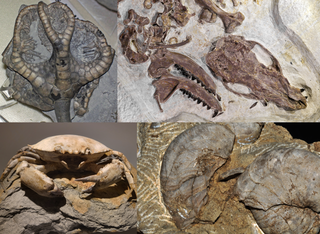
A fossil is any preserved remains, impression, or trace of any once-living thing from a past geological age. Examples include bones, shells, exoskeletons, stone imprints of animals or microbes, objects preserved in amber, hair, petrified wood and DNA remnants. The totality of fossils is known as the fossil record. Though the fossil record is incomplete, numerous studies have demonstrated that there is enough information available to give a good understanding of the pattern of diversification of life on Earth. In addition, the record can predict and fill gaps such as the discovery of Tiktaalik in the arctic of Canada.

Coelacanths are an ancient group of lobe-finned fish (Sarcopterygii) in the class Actinistia. As sarcopterygians, they are more closely related to lungfish and tetrapods than to ray-finned fish.

Marlins are fish from the family Istiophoridae, which includes 11 species.

Ophidia is a group of squamate reptiles including modern snakes and reptiles more closely related to snakes than to other living groups of lizards.

Otodus megalodon, commonly known as megalodon, is an extinct species of giant mackerel shark that lived approximately 23 to 3.6 million years ago (Mya), from the Early Miocene to the Early Pliocene epochs. O. megalodon was formerly thought to be a member of the family Lamnidae and a close relative of the great white shark, but has been reclassified into the extinct family Otodontidae, which diverged from the great white shark during the Early Cretaceous.
Romer's gap is an apparent gap in the Paleozoic tetrapod fossil record used in the study of evolutionary biology, which represent periods from which excavators have not yet found relevant fossils. It is named after American paleontologist Alfred Romer, who first recognised it in 1956. Recent discoveries in Scotland are beginning to close this gap in palaeontological knowledge.

Nothosaurs were Triassic marine sauropterygian reptiles. They averaged about 3 metres (10 ft) in length, with a long body and tail. The feet were paddle-like, and are known to have been webbed in life, to help power the animal when swimming. The neck was quite long, and the head was elongated and flattened, and relatively small in relation to the body. The margins of the long jaws were equipped with numerous sharp outward-pointing teeth, indicating a diet of fish and squid.
Halimornis was an enantiornithean bird. It lived during the Late Cretaceous about 80 mya and is known from fossils found in the Mooreville Chalk Formation in Greene County, Alabama. It is known from a single fossil individual, including preserved vertebrae, leg bones and part of the humerus.
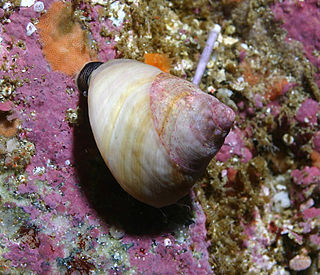
Trochoidea is a superfamily of small to very large vetigastropod sea snails with gills and an operculum. Species within this superfamily have nacre as the inner shell layer. The families within this superfamily include the Trochidae, the top snails. This superfamily is the largest vetigastropodan superfamily, containing more than 2,000 species.

Marine invertebrates are invertebrate animals that live in marine habitats, and make up most of the macroscopic life in the oceans. It is a polyphyletic blanket term that contains all marine animals except the marine vertebrates, including the non-vertebrate members of the phylum Chordata such as lancelets, sea squirts and salps. As the name suggests, marine invertebrates lack any mineralized axial endoskeleton, i.e. the vertebral column, and some have evolved a rigid shell, test or exoskeleton for protection and/or locomotion, while others rely on internal fluid pressure to support their bodies. Marine invertebrates have a large variety of body plans, and have been categorized into over 30 phyla.

Penion is a genus of large marine snails, commonly known as siphon whelks, classified within the mollusc family Austrosiphonidae.

Notochelone is an extinct genus of sea turtle, which existed about 100 million years ago. The species was first described by Richard Owen in 1882 as Notochelys costata. It was renamed by Richard Lydekker in 1889. It was the most common marine reptile living in the inlands of the sea around Queensland, Australia. It was small turtle with carapace less than 1 metre (3.3 ft). Analytical studies have indicated that the creatures frequently ate benthic molluscs.
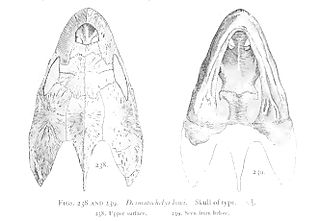
Desmatochelys is an extinct genus of sea turtles belonging to the family Protostegidae. This genus contains two known species, D. lowii and D. padillai. D. lowii was first discovered in 1895, followed by D. padillai in 2015. Having been estimated at over 120 million years old, D. padillai is currently the oldest known species of sea turtle.
Cyphornis is a genus of the prehistoric pseudotooth birds. These were probably rather close relatives of either pelicans and storks, or of waterfowl, and are here placed in the order Odontopterygiformes to account for this uncertainty.

Ecrinesomus is an extinct genus of prehistoric marine bobasatraniiform ray-finned fish that lived during the late Induan age of the Early Triassic epoch. It is known from the Sakamena Formation of Madagascar.
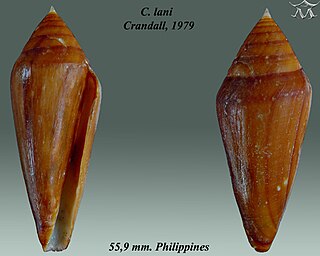
Profundiconus is a genus of sea snails, marine gastropod mollusks in the family Conidae, the cone snails and their allies.
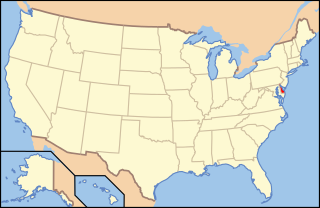
Paleontology in Delaware refers to paleontological research occurring within or conducted by people from the U.S. state of Delaware. There are no local rocks of Precambrian, Paleozoic, Triassic, or Jurassic age, so Delaware's fossil record does not begin until the Cretaceous period. As the Early Cretaceous gave way to the Late Cretaceous, Delaware was being gradually submerged by the sea. Local marine life included cephalopods like Belemnitella americana, and marine reptiles. The dwindling local terrestrial environments were home to a variety of plants, dinosaurs, and pterosaurs. Along with New Jersey, Delaware is one of the best sources of Late Cretaceous dinosaur fossils in the eastern United States. Delaware was still mostly covered by sea water through the Cenozoic era. Local marine life included manatees, porpoises, seals, and whales. Delaware was worked over by glaciers during the Ice Age. The Cretaceous belemnite Belemnitella americana is the Delaware state fossil.

Crustaceans are invertebrate animals that constitute one group of arthropods that are a part of the subphylum Crustacea, a large, diverse group of mainly aquatic arthropods including decapods, seed shrimp, branchiopods, fish lice, krill, remipedes, isopods, barnacles, copepods, opossum shrimps, amphipods and mantis shrimp. The crustacean group can be treated as a subphylum under the clade Mandibulata. It is now well accepted that the hexapods emerged deep in the Crustacean group, with the completed pan-group referred to as Pancrustacea. The three classes Cephalocarida, Branchiopoda and Remipedia are more closely related to the hexapods than they are to any of the other crustaceans.

Conus is a genus of venomous and predatory sea snails, or cone snails, marine gastropod mollusks in the family Conidae. Prior to 2009, it included all cone snail species but is now more precisely defined, as are other cone snail genera.
References
- 1 2 SEPKOSKI, J. (2002). "A compendium of fossil marine animal genera (Trilobita entry)". Bulletins of American Paleontology. 364: 560. Retrieved 2008-01-12.
- ↑ POLETAEVA, O. K. 1956. Semejstvo Triniidae Poletayeva fam. nov., p. 178–179. In Kiparisova, L. D., Markovskij, B. P., and Radchenko, G. P. (eds.), Materialy po paleontologii. Novye semejstva i rody. Vsesoyuznyi Nauchno-issledovatel'skii Geologicheskii Institut (VSEGEI), Trudy, Novaya Seriya, 12.